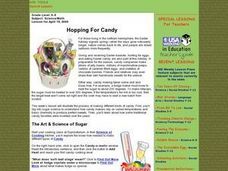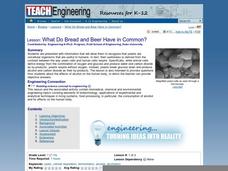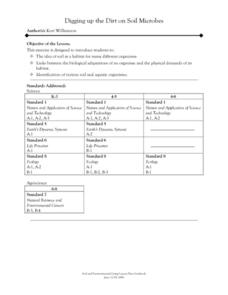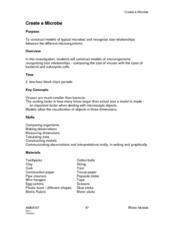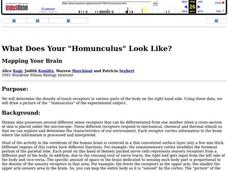Curated OER
Bridging the Gaps Between the Three Worlds of Chemistry
Young scholars examine the observed world, molecular world, and the symbolic world of chemistry. They observe a demonstration of the conductivity of solutions, describe the properties of acids and bases, and predict the outcome of...
Curated OER
Murder Mystery
High schoolers examine how to capture foot prints while they simulate a criminal investigation. They discover how the clues are needed for identifying or eliminating murder suspects.
Curated OER
Hopping For Candy
Students explore recipes online for different types of candy, and simulate process of making candy to explain how candy makers rely on varied temperatures and basic chemistry to produce perfect sweets.
Michigan Sea Grant
Invasive Species
Learners identify invasive species to the Great Lakes and analyze their impact on the ecosystem. Using photo cards with pictures and facts, young scientists work in small groups to match invasive species with their corresponding...
Curated OER
Food Webs in a Pond
Learners explore food chains and food webs in a pond and identify common creatures found in ponds. They look for tadpoles, fish, mites and other creatures in a pond during a field trip for first hand research.
Curated OER
Bacteria: The good, the bad, the ugly
Seventh graders conduct an experiment. In this bacteria lesson, 7th graders list living and nonliving things and brainstorm the characteristics they share. Students are divided into two groups where they put samples of hand...
Curated OER
Mission Possible
Learners, in teams, solve a crime using forensic lab techniques. They apply lab techniques to a real life situation using a crime scenario that takes place on campus. Sample activities include Blood, Fiber, and Hair Lab.
Curated OER
Crystals in the World around Us
Students grow a number of crystals, ask questions and experiment. They have a display showing their crystals in various stages of development. Additionally, they have models of crystals to take home. They study the forces that shape...
Curated OER
Frogs
Students explore the external and internal structures of an amphibian and how frog anatomy compares to human anatomy. They collect pictures of a frog using a digital camera, create a web page, develop a PowerPoint presentation, and...
Curated OER
Extreme Flashlight Tag
Fifth graders view a Powerpoint show about reflecting light. They experiment through a reflection simulation on the internet. Students complete the activity by using mirrors and light to complete send light to a specified spot.
Curated OER
Stations of Light
Student groups rotate through four stations to examine light energy behavior: refraction, magnification, prisms and polarization. They see how a beam of light is refracted (bent) through various transparent mediums. Young scholars...
Curated OER
What Do Bread and Beer Have in Common?
Students listen to an explanation of yeast cells and how they effect bread and beer. They discuss the ways alcohol affects the human body and participate in an indirect observation about cell respiration in yeast-molasses cultures.
Curated OER
Digging up the Dirt on Soil Microbes
Learners are introduced to the idea of soil as a habitat for many different organisms. They are introduced to the links between the biological adaptations of an organism and the physical demands of its habitat. Pupils are introduced to...
Curated OER
Create a Microbe
Students construct models of microorganisms recognizing size relationships-comparing the size of viruses with the sizes of bacterial and eukaryotic cells. They put into perspective just how small microbes are by comparing the size of...
Curated OER
Frosty the Snowman Meets His Demise: An Analogy to Carbon Dating
Learners read and discuss an article about carbon dating, then participate in a hands-on lab to discover how carbon dating works. Students also write a letter to a friend explaining the process, and how archeologists use the process to...
Curated OER
Digestible Computers
Students examine the pros and cons of 'embedded computing' in the field of medicine. They invent and describe a computer that would be embedded in an individual to improve their education or school and write essays critiquing their...
Curated OER
Air Matters
Middle schoolers research the affects that particulate matter has on the quality of our air and our health. Students analyze a streaming video on air pollution and complete an internet research assignment to find ways to reduce...
Curated OER
Electrophoresis Analogy
Students use and listen to analogies to help them become familiar with electrophoresis. One example is: Imagine a huge swimming pool full of water and many entangled nets (this is the agarose gel). A dump truck comes along and dumps...
Curated OER
Using Magnetotactic Bacteria to Study Natural Selection
Students observe bacteria that are able to orient themselves using the Earth's magnetic field.They comprehend the difference between anaerobic and aerobic organisms. Students can tell the difference of the shape of magnetic force field...
Curated OER
Ecological Succession in Pond Water Cultures
Students collect samples of pond water, dried grass, and soil in a jar. They predict the order of ecological succession in their pond water cultures. They compare their expected results with their observed results.
Curated OER
Biological Concepts
Learners perform a transection of a redworm. They discuss spinal cord injuries in humans. Students compare the ability of the redworm to regenerate the ventral nerve cord with the inability of humans to repair damage to the dorsal nerve...
Curated OER
What Does Your "Homunculus" Look Like?
Students investigate the density of touch receptors in various parts of the body. They discover how the body senses various stimuli, then maps a picture of the "homunculus" of the experimental subject.
Curated OER
Edible Algae
Young scholars acquire an awareness and appreciation for the value of the organisms in the Protist Kingdom. They identify common Protists, name them and list some common products that contain marine algae.
Curated OER
Mohs Hardness Test
Fifth graders listen as they are told about another way to classify rocks; by their hardness. They observe the Mohs Hardness Test overhead, discover how the test works, and then use materials such as pennies, butter knives, nails, and...
Other popular searches
- Compound Microscopes
- Dissection Microscopes
- Biology Lab Microscopes
- Scanning Electron Microscopes
- Cheek Cells and Microscopes
- Lesson Plan on Microscopes
- Lenses and Microscopes
- Microscopes and Cells
- Forensics and Microscopes
- Microscopes and Water
- 18 Century Microscopes
- Light Microscopes


